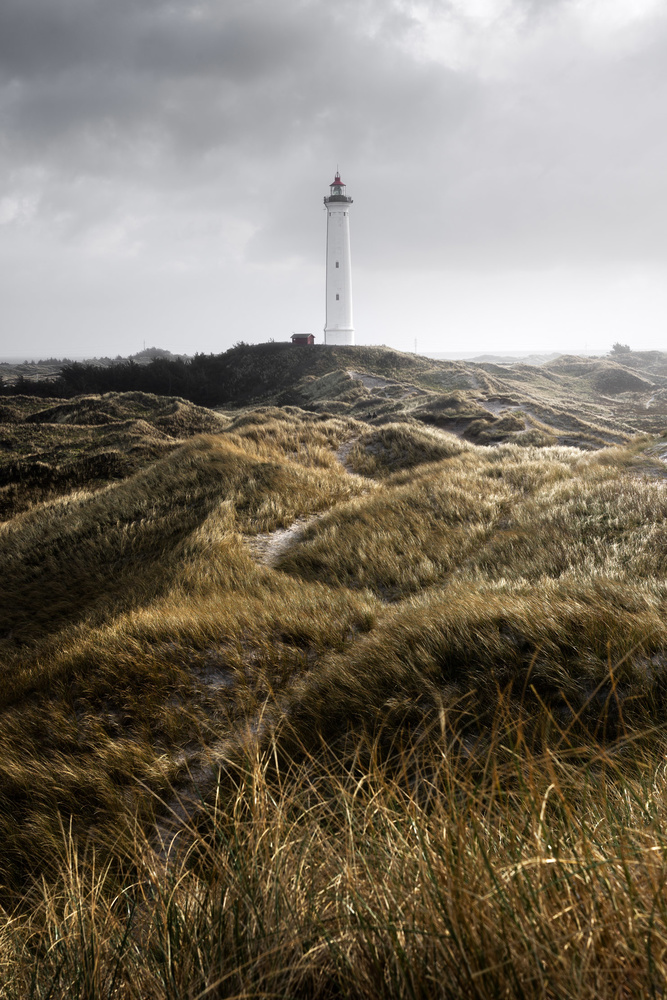“A wide angle lens is the best for landscape photography.” Does that sound familiar? I am continuously surprised by how little I use the wide angle lens.
In the above video, I went to a beautiful lighthouse along the western coast of Jutland in Denmark. I have wanted to visit this lighthouse for a very long time, and when I got the opportunity to combine a visit with the back end of a storm, the potential for great photographs was there.
When I visit a new location, I usually approach it with my 24-105mm attached to the camera, and it was no different on this day. The 24-105mm is an incredibly versatile lens, covering the field of view from the wide to short telephoto range. As it turned out, I did not need to take off the lens the entire day.

Shot at 44mm with a slight crop.
Dimensions of the Photograph
The first thing I had to consider at this location was the dimensions of the lighthouse. This lighthouse was very tall compared to its width (it is a tower after all), and that meant it took up very little of the photo. Because of its height, most of my photos ended up in portrait format, as I wanted to include a near foreground. You can go through the photos in the article and compare the portrait-oriented photos with the landscape-oriented photos below. The lighthouse very quickly becomes very small in the landscape-oriented photos with a near foreground.

Shot at 66mm without a near foreground.

Shot at 29mm with a near foreground.

Shot at 29mm with a near foreground.
The second thing I had to consider was the distance to the lighthouse. In my experience photographing these types of lighthouses, I know distance is key. The problem with getting too close is you will need to use a wide angle lens, and it creates a perspective I do not like. The lighthouse looks distorted because of the close distance. This might work in nature, but for buildings, it can be problematic. Adding distance, you look at the lighthouse instead of up it.
What About Depth?
The third thing to consider was how to incorporate the landscape into the frame to create a perception of depth. Since I had freed myself from the wide angle perspective, I had opened up a much larger area for potential foregrounds. The larger the area, the more opportunity to find the best possible foreground, which in turn optimizes your chance for the “best” possible photo. This place is a dune area and a well-visited beach during summer, which means there was a lot of grass and many trails I could use as elements in the foreground to create the perception of depth. With the larger distance to the lighthouse, I would have to zoom in beyond the typical 35mm, where the wide angle zoom lenses end, but that risked removing the sense of depth. When you use a wide angle and you want to include a foreground, you often want to get low and close to the foreground element, but to include foreground and get a perception of depth, when I used a longer focal length, I actually had to move a bit back and zoom in instead. Check out the before/after photo below, where I use two different focal lengths (46mm and 63mm), yet get approximately the same foreground effect at the expense of the middle ground.
What About Drama?
If I had been in a more dramatic landscape with a mountain in the background, it would be obvious to use a wide angle lens to achieve a wider field of view so as to include everything in the scene in my photograph, just as I did when I was at Stokksnes in Iceland. However, as this landscape did not include mountains and was not particularly dramatic, I had to create the drama using another lens. My scene of interest was relatively narrow and therefore did not require a wide angle lens. Had I used the wide angle lens, let us say at 16mm, I would have included way too much of the landscape and left the lighthouse as a tiny line in the distance. By zooming in, I exclude all the clutter and make the photo much more to the point and arguably more dramatic.

Shot at 59mm.
Which One Is the Best?
As I photograph the not-so-dramatic landscapes of Denmark more and more, I am really starting to feel it is a myth that the wide angle lens is the best for landscape photography. It is not just a myth; it is actually just wrong. The “best” lens for landscape photography at this location I would argue is the 24-105mm. Some photographers say the 16-35mm is the best, others the 70-200mm (or longer), but let me add a bit of gasoline to the conversation and say the 24-105mm is the best. In fact, it is highly subjective, and stating which one is the “best” lens always comes with an “it depends.” What lens works the best is always relative to the specific landscape, location, and vision of the photographer. That is why I usually preach you need to cover as wide a range of focal lengths as possible.
Check out the video above to see some stormy landscape photography. Which one is your most used lens?








I'm happy to hear that, Leon :)
Shot at 13:30 is my pick. Great photos all though. Brave to take the gear in the blowing sand!
Is that THE Lighthouse from the movie?
Its all subjective, I shoot with a Tamron 15-30 which is on my camera 97% of the time.
The wider the better but that works for me and my style, just do what works for you and your style :-)